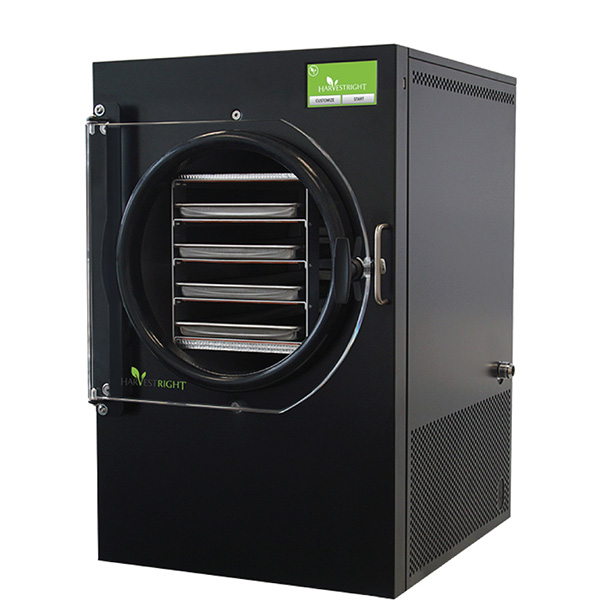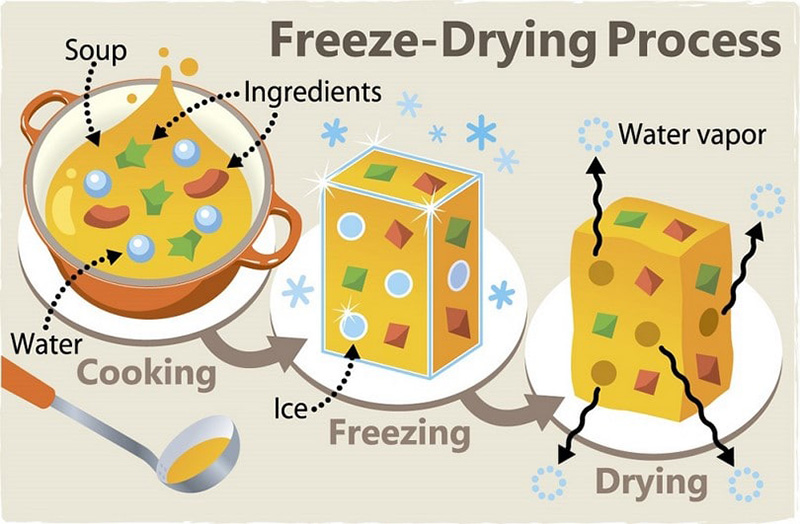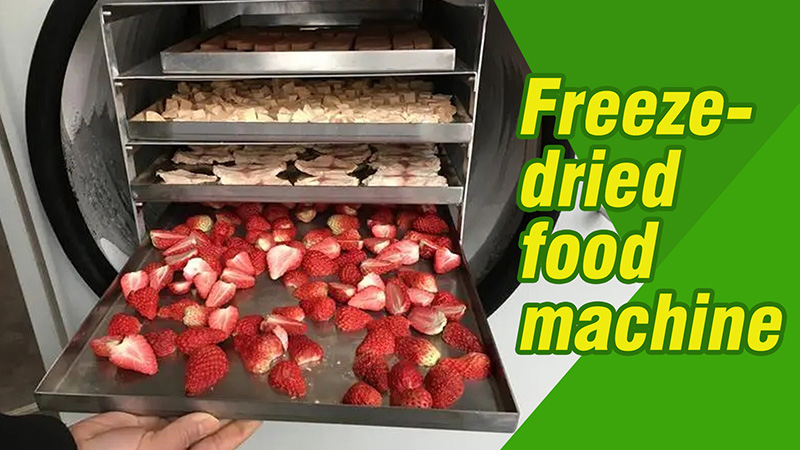
Content Menu
● Introduction to Freeze Drying
● Understanding the Freeze Drying Process
● The Rise of Home Freeze Dryers
>> Benefits of Using a Machine to Freeze Dry Food at Home
● Choosing the Right Machine to Freeze Dry Food
>> 1. Capacity
>> 2. Energy Efficiency
>> 3. Ease of Use
>> 4. Noise Level
>> 5. Warranty and Customer Support
● Popular Freeze Dryer Brands and Models
>> 1. Harvest Right
>> 2. Freeze Dry Machine
>> 3. Blue Alpine
● Getting Started with Your Home Freeze Dryer
>> 1. Set Up Your Freeze Dryer
>> 2. Prepare Your Food
>> 3. Start the Freeze Drying Process
>> 4. Monitor the Process
>> 5. Store Your Freeze-Dried Food
● Exploring Freeze-Dried Foods
>> Freeze-Dried Fruits and Vegetables
>> Freeze-Dried Meats
>> Freeze-Dried Dairy Products
>> Freeze-Dried Meals
>> Freeze-Dried Snacks
● Tips for Successful Freeze Drying
● The Future of Home Food Preservation
● Conclusion
● Frequently Asked Questions
>> 1. How long does it take to freeze dry food at home?
>> 2. Is freeze-dried food healthy?
>> 3. How do you rehydrate freeze-dried food?
>> 4. Can you freeze dry any type of food?
>> 5. How much does a home freeze dryer cost?
Introduction to Freeze Drying
Freeze drying, also known as lyophilization, is a cutting-edge food preservation method that has gained significant popularity among home enthusiasts and food industry professionals alike. This process involves removing moisture from food while preserving its nutritional value, flavor, and texture. At the heart of this innovative technique is the machine to freeze dry food, a remarkable piece of technology that has revolutionized how we approach long-term food storage and emergency preparedness.
Understanding the Freeze Drying Process
The freeze drying process consists of three main stages:
1. Freezing: The food is rapidly frozen to temperatures below -40°F (-40°C).
2. Primary drying: The frozen water in the food is sublimated, turning directly from ice to vapor under low pressure.
3. Secondary drying: Any remaining bound water is removed through desorption.
This process results in food that retains up to 97% of its nutritional value and can be stored for up to 25 years when properly packaged.
The Rise of Home Freeze Dryers
In recent years, the availability of home freeze dryers has made this technology accessible to individuals and families. Companies like Harvest Right have pioneered the development of compact, user-friendly freeze dryers designed for home use. These machines have opened up a world of possibilities for food preservation enthusiasts, preppers, and health-conscious consumers.
Benefits of Using a Machine to Freeze Dry Food at Home
1. Long-term food storage: Freeze-dried foods can last up to 25 years when properly stored.
2. Nutritional preservation: The process retains up to 97% of the food's original nutritional value.
3. Flavor and texture retention: Freeze-dried foods maintain their original taste and reconstitute well.
4. Versatility: You can freeze dry a wide variety of foods, including fruits, vegetables, meats, and even complete meals.
5. Cost-effective: While the initial investment in a freeze dryer may be significant, it can save money in the long run by reducing food waste and allowing bulk purchases.
6. Customization: You have complete control over the ingredients and portion sizes of your freeze-dried foods.
7. Emergency preparedness: Create a stockpile of nutritious, long-lasting food for emergencies or natural disasters.
Choosing the Right Machine to Freeze Dry Food
When selecting a home freeze dryer, consider the following factors:
1. Capacity
Freeze dryers come in various sizes, typically categorized as small, medium, and large. The right size for you depends on your household size, frequency of use, and storage space. For example, the Harvest Right Large Pro model can freeze dry up to 27 lbs of food per batch and has 1107 sq. inches of tray space.
2. Energy Efficiency
Look for models with energy-efficient features, as freeze dryers can consume a significant amount of electricity during operation.
3. Ease of Use
Choose a machine with user-friendly controls and clear instructions. Many modern freeze dryers come with programmable settings and digital displays for easy operation.
4. Noise Level
Consider the noise level of the freeze dryer, especially if you plan to run it overnight or in shared living spaces.
5. Warranty and Customer Support
Invest in a freeze dryer from a reputable manufacturer that offers a solid warranty and reliable customer support.

Popular Freeze Dryer Brands and Models
1. Harvest Right
Harvest Right is a leading manufacturer of home freeze dryers, offering models in various sizes and finishes. Their products are known for their quality and user-friendly design.
2. Freeze Dry Machine
This brand offers commercial-grade freeze dryers suitable for small businesses and serious home users.
3. Blue Alpine
Blue Alpine produces freeze dryers with innovative features and competitive pricing.
Getting Started with Your Home Freeze Dryer
Once you've chosen your machine to freeze dry food, follow these steps to get started:
1. Set Up Your Freeze Dryer
Choose a well-ventilated area with a stable temperature and follow the manufacturer's instructions for setup and initial testing.
2. Prepare Your Food
Wash, slice, and arrange your food items on the freeze dryer trays. Ensure even distribution for optimal results.
3. Start the Freeze Drying Process
Load the trays into your machine and initiate the freeze drying cycle. Most home freeze dryers have pre-programmed settings for different food types.
4. Monitor the Process
While modern freeze dryers are largely automated, it's a good idea to check on the progress periodically, especially during your first few batches.
5. Store Your Freeze-Dried Food
Once the cycle is complete, package your freeze-dried food in airtight containers or mylar bags with oxygen absorbers for long-term storage.

Exploring Freeze-Dried Foods
The versatility of a machine to freeze dry food allows you to preserve a wide variety of items:
Freeze-Dried Fruits and Vegetables
Fruits and vegetables are excellent candidates for freeze drying. They retain their vibrant colors, flavors, and nutritional value. Popular options include:
- Strawberries
- Bananas
- Apples
- Blueberries
- Peas
- Corn
- Bell peppers
Freeze-Dried Meats
Meats can be freeze-dried raw or cooked. They make excellent additions to camping meals or emergency food supplies. Examples include:
- Chicken
- Beef
- Turkey
- Fish
Freeze-Dried Dairy Products
Dairy products freeze dry well and can be reconstituted for use in recipes or as standalone snacks:
- Cheese
- Yogurt
- Milk
Freeze-Dried Meals
Complete meals can be freeze-dried for convenient, long-term storage. This is particularly useful for outdoor enthusiasts and emergency preparedness:
- Soups and stews
- Casseroles
- Pasta dishes
Freeze-Dried Snacks
Create unique and healthy snacks by freeze drying various foods:
- Ice cream (yes, you can freeze dry ice cream!)
- Yogurt drops
- Fruit and vegetable chips
Tips for Successful Freeze Drying
To get the most out of your machine to freeze dry food, consider these tips:
1. Pre-freeze liquids and high-moisture foods to reduce freeze drying time.
2. Cut foods into uniform sizes for even drying.
3. Avoid overloading trays, as this can extend the drying time and affect quality.
4. Experiment with different pre-treatments, such as dipping fruits in ascorbic acid solution to prevent browning.
5. Keep detailed records of your freeze drying batches to refine your process over time.
6. Clean your freeze dryer regularly according to the manufacturer's instructions to maintain optimal performance.
The Future of Home Food Preservation
As technology continues to advance, we can expect to see further innovations in home freeze drying equipment. Future developments may include:
- More energy-efficient models
- Smaller, more compact designs for urban dwellers
- Integration with smart home systems for remote monitoring and control
- Advanced sensors for optimizing the freeze drying process based on food type and moisture content
The growing interest in sustainable living and food security suggests that the popularity of home freeze dryers will continue to rise, making the machine to freeze dry food an increasingly common sight in kitchens around the world.
Conclusion
The machine to freeze dry food has revolutionized home food preservation, offering a way to create long-lasting, nutritious, and delicious food stores. Whether you're preparing for emergencies, reducing food waste, or simply exploring new culinary possibilities, a home freeze dryer opens up a world of opportunities. By understanding the process, choosing the right equipment, and experimenting with different foods, you can master the art of freeze drying and enjoy its many benefits for years to come.

Frequently Asked Questions
1. How long does it take to freeze dry food at home?
Answer: The freeze drying process typically takes between 20 to 40 hours, depending on the type and quantity of food being processed. Factors such as moisture content, pre-freezing, and the efficiency of your machine can affect the duration.
2. Is freeze-dried food healthy?
Answer: Yes, freeze-dried food is very healthy. The process preserves up to 97% of the original nutritional value of the food, including vitamins, minerals, and enzymes. Unlike other preservation methods, freeze drying doesn't require the addition of preservatives or chemicals.
3. How do you rehydrate freeze-dried food?
Answer: To rehydrate freeze-dried food, simply add water. The amount of water needed varies depending on the food item. Generally, you'll want to use slightly less water than the original moisture content of the food. Let the food sit in the water for 5-10 minutes, or until it reaches the desired consistency.
4. Can you freeze dry any type of food?
Answer: While you can freeze dry most foods, some items work better than others. Foods with high fat content, such as avocados or fatty meats, don't freeze dry well. Foods with high sugar content may become sticky. However, most fruits, vegetables, lean meats, dairy products, and even complete meals can be successfully freeze-dried.
5. How much does a home freeze dryer cost?
Answer: The cost of a home freeze dryer can vary significantly depending on the size and features. As of 2024, prices typically range from $2,000 to $5,000 for consumer-grade models. While this represents a significant investment, many users find that the long-term savings on food preservation and the ability to create emergency food supplies justify the cost.











